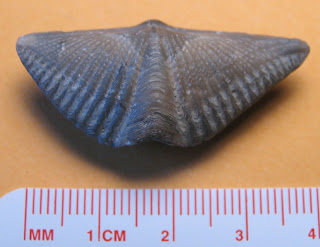Pages
▼
Monday, May 31, 2010
Alispirifer imbricatus brachiopod
This brachiopod seems to match one shown on the Indiana State Museum collection database website that is identified as Cf. Alispirifer imbricatus nomen nudem. Just to clarify some details of this name as I rarely use some of these terms on the blog, Cf. is the abbreviation of the Latin "confer". My interpretation of this is the fossil is like another fossil but the identification is not sure. "Nomen nudem" is Latin for "naked name" which in this context means the scientific name is not official because it was not published or incorrectly published.
My cousin gave me this specimen found on a recent hike in Indiana. It was found in Washington County, Indiana from the Mississippian Period and probably from the Borden Group (Spickert Knob Formation). The fossil appears to be an internal cast. The rock it consists of is hard, he had another fossil I was trying remove a nodule from with the engraver. With the engraver set at its highest level the rock would not break off.
Learn more about Indiana's past by visiting the Indiana State Museum Center for Science and Culture. While there: Celebrate. Investigate. Remember. Learn.
Saturday, May 29, 2010
Heliophyllum of the North Vernon Limestone
Heliophyllum sp. horn coral found in the Beechwood Member of the North Vernon Limestone of Clark County, Indiana. This coral existed in the Devonian Period.
Friday, May 28, 2010
Schlotheimophyllum or Ptychophyllum Horn Coral
These Middle Silurian Period (428-423 mya) horn corals are from the Louisville Limestone of Jefferson County, Kentucky. They appear to be Schlotheimophyllum (referred to by William Davis as Ptychophyllum). Usinig Erwin Stumm's book Silurian and Devonian Corals of the Falls of the Ohio, these horn corals might be Schlotheimophyllum fulcratum (aka by Davis as Ptychophyllum stokesi) or Schlotheimophyllum ipomaea. Another author Herzer in 1902 referred the genus as Chonophyllum.
Stumm refers to these as scattered hollow spines (p.25) when describing the Schlotheimophyllum fulcratum but I believe they are some sort of holdfast or anchor device used by the coral to connect itself to the sea floor/object or another horn coral.
These last three images are of plates from Davis's monograph that have been photo enhanced and labeled. These horn coral specimens were labeled Ptychophyllum stokesi of the Upper Niagara Limestone [now called Louisville Limestone]. Images from book: Kentucky Fossil Corals - A Monograph of the Fossils Corals of the Silurian and Devonian Rocks of Kentucky by William J. Davis, Kentucky Geological Survey 1887. Thanks to Kentucky Geological Survey website of Plate 105.
Thursday, May 27, 2010
Compressiphyllum davisana
Compressiphyllum davisana Miller horn coral fossil found in the Jeffersonville Limestone of Clark County, Indiana. Creature existed in the Devonian Period.
Tuesday, May 25, 2010
Athyris spiriferoides
Athyris spiriferoides (Eaton) brachiopod found in the Wanakah Member:Ludlowville Formation, Hamilton Group of Erie County, New York. This animal existed in the Middle Devonian Period (397-385 million years ago). Learn more about this New York site visit this web page. Thanks to Dave for the specimens.
Monday, May 24, 2010
Venericardia rotunda Clam
This clam fossil was found in Monroe County, Alabama in the Gosport Sand. It existed in the Paleogene Period and is probably a Venericardia rotunda. Thanks to Herb & Pam for the fossil.
Sunday, May 23, 2010
Callista perovata Eocene Clam
This clam fossil was found in Monroe County, Alabama in the Gosport Sand. It existed in the Eocene Epoch and is probably a Callista perovata lisbonensis. Thanks to Herb & Pam for the fossil plus the identification help.
Saturday, May 22, 2010
Friday, May 21, 2010
Mucrospirifer thedforensis Brachiopod
The Mucrospirifer thedforensis brachiopod ("butterfly shells") found in the Widder Formation of Arkona, Ontario, Canada. This creature lived in the Givetian Age (392-386 million years ago) of the Middle Devonian Period.
According to Wikipedia, this brachiopod is in the class Rhynchonellata (Articulata) and the order Spiriferida. The fossil shell definitely has beautiful wing shapes.
This page has an artistic interpretation of what a similar species might have looked like. One has to be impressed by the artist Emily S. Damstra's work.
Thanks to Dave for the fossils.
Thursday, May 20, 2010
Eurypterid Fossil Fragment
This fossil is of the prosoma ("head") of an Eurypterid ("sea scorpion"). This specimen was found at the Ridgemount Quarry in Fort Erie, Ontario, Canada. Its identification might be an Eurypterus lacustris (Harlan). This particular fossil was found in the Fiddlers Green Member of the Bertie Dolestone of the Williamsville Formation. This creature probably existed about 423-418 million years ago (upper Silurian Period). See this website for more details.
Thanks to Dave for sending this fossil to me.
Thanks to Dave for sending this fossil to me.
Wednesday, May 19, 2010
Turritella Gastropod of Alabama
About 60 million years ago (or so) during the Paleocene epoch, a towering coiled shell sea gastropod roamed a shallow sea that is now where southern Alabama is in the United States. Fast forward to the early 1800s, Timothy Abbott Conrad from the Academy of Natural Sciences of Philadelphia spends years studying the shell fossils of Monroe County, Alabama. His studies result in a book Fossil Shells of the Tertiary Formations of North America which a reproduction of can be found at Google Books website.
The fossil pictures in this post were found in the Gosport Sand or Lisbon Formation of the Paleocene Epoch/Eocene Period. The location was Monroe County, Alabama, USA. This gastropod fossils might be the Turritella mortoni?. Thanks to Pam and Herb for these fossils.
Close up of spiral point.
Tuesday, May 18, 2010
The Inner Atrypa
Above is a diagram of a North African Atrypa reticularis from the Middle Devonian Period. It is on display at the Museum of Natural History in Paris, France.
This next image is of both sides of a Pseudoatrypa found in the Jeffersonville Limestone of Clark County, Indiana.
This last picture is another example of the Pseudoatrypa from the same locality though in a little rougher shape.



















































